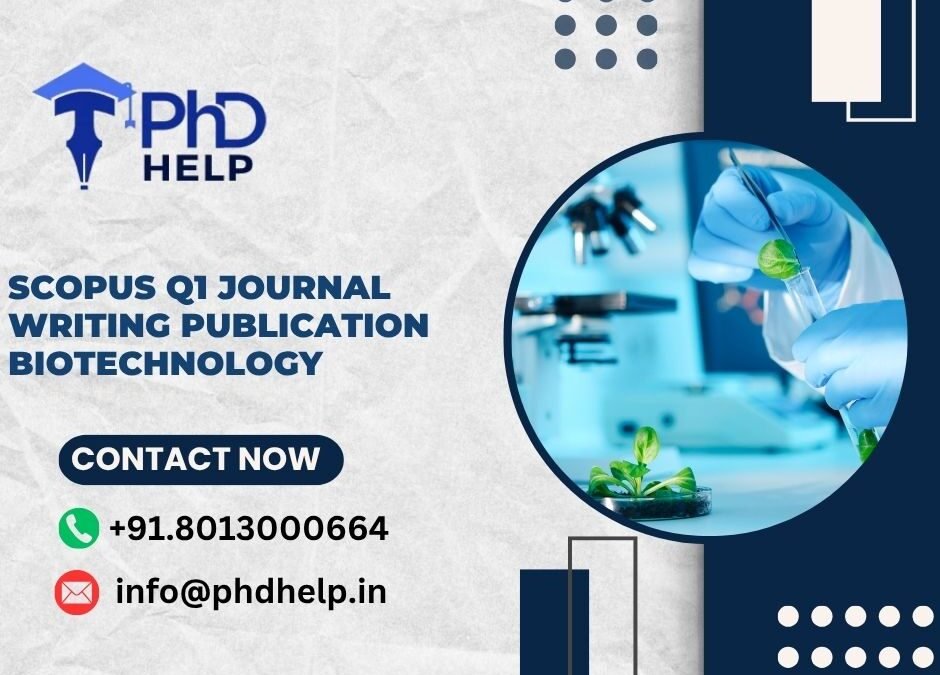SCOPUS Q1 journal writing publication Biotechnology
SCOPUS Q1 journal writing publication Biotechnology. Publishing in a SCOPUS Q1 journal in Biotechnology represents a significant achievement for researchers exploring innovative biological applications in medicine, agriculture, industry, and environmental science. Biotechnology integrates molecular biology, genetics, bioengineering, and computational biology to develop technologies that solve real-world problems. Securing publication in a Q1-ranked SCOPUS journal not only demonstrates research excellence but also ensures your work contributes meaningfully to global scientific progress. This guide provides a comprehensive roadmap for writing, structuring, and publishing high-impact research in SCOPUS Q1 Biotechnology journals.
Understanding SCOPUS Q1 Journals in Biotechnology
SCOPUS is one of the most authoritative abstract and citation databases, ranking journals based on CiteScore, SNIP (Source Normalized Impact per Paper), and SJR (SCImago Journal Rank).
Journals in the Q1 quartile are in the top 25% of their field, known for rigorous peer review, high impact, and global readership. In Biotechnology, Q1 journals publish research in areas such as:
-
Genetic Engineering and Synthetic Biology
-
Bioinformatics and Computational Biotechnology
-
Enzyme Engineering and Biocatalysis
-
Cell and Tissue Engineering
-
Bioprocess and Industrial Biotechnology
-
Environmental and Agricultural Biotechnology
Prominent SCOPUS Q1 Biotechnology journals include Biotechnology Advances, Trends in Biotechnology, Bioresource Technology, Journal of Biotechnology, and Current Opinion in Biotechnology.
Key Features of SCOPUS Q1 Biotechnology Journals
Q1 journals in Biotechnology are distinguished by several attributes:
-
High Citation Impact: Reflects the journal’s influence in both academic and industrial biotechnology.
-
Rigorous Peer Review: Ensures methodological accuracy, reproducibility, and innovation.
-
Emphasis on Novelty: Publishes research introducing new technologies, methodologies, or applications.
-
Interdisciplinary Reach: Bridges molecular biology, bioengineering, computational methods, and industrial applications.
-
Global Readership: Ensures worldwide visibility among scientists, researchers, and industry leaders.
Selecting the Right SCOPUS Q1 Journal for Your Research
Choosing the appropriate journal increases the likelihood of acceptance. Consider the following:
-
Research Scope Alignment: Ensure your study matches the journal’s thematic focus.
-
Impact Metrics: Higher CiteScore and SJR indicate greater visibility and influence.
-
Open Access vs Subscription: Open access boosts readership but may require publication fees.
-
Acceptance Rate and Timeline: Consider peer review speed and publication frequency.
-
Target Audience: Decide if your research appeals more to academic, clinical, or industrial readers.
Careful journal selection is a strategic step toward successful publication.
Structuring a High-Impact Biotechnology Manuscript
A SCOPUS Q1 Biotechnology manuscript should be structured for clarity, precision, and scientific rigor.
1. Title and Abstract
Your title must be informative, concise, and include keywords relevant to your research, such as “synthetic biology,” “bioprocess optimization,” or “genetic engineering.”
The abstract should summarize objectives, methods, significant findings, and implications in 200–250 words, highlighting novelty and real-world applications.
2. Introduction
The introduction should:
-
Define the research gap
-
Justify the significance of the study
-
Cite recent Q1 journal references
-
End with a clear research objective or hypothesis
3. Methodology
The methods section must be transparent and reproducible:
-
Experimental Design: Cell lines, microbial strains, or plant systems used
-
Biotechnological Techniques: CRISPR, recombinant DNA, metabolic engineering, or bioreactors
-
Analytical Methods: Flow cytometry, mass spectrometry, chromatography, or computational simulations
-
Statistical Analysis: Describe software and methods used for data interpretation
Clear methodology is critical for reviewer confidence.
4. Results and Discussion
Present findings with figures, graphs, tables, and process schematics. Discuss:
-
Biotechnological relevance and novelty
-
Optimization outcomes in genetic or enzymatic systems
-
Applications in medicine, agriculture, or industry
-
Comparisons with existing studies
Interpretation should highlight both scientific and practical significance.
5. Conclusion
Summarize the key outcomes, technological impact, and future research potential. Focus on how your findings advance biotechnology.
Data Visualization and Representation
High-quality visuals are essential in Biotechnology research:
-
Graphs and Charts: For enzyme kinetics, cell growth, or gene expression analysis
-
Flow Diagrams: For bioprocess design or synthetic pathways
-
3D Molecular Models: For protein engineering or metabolic pathway visualization
Software tools like GraphPad Prism, PyMOL, MATLAB, and R enhance clarity and reproducibility.
Ethics and Scientific Integrity
Maintaining ethical standards is mandatory for SCOPUS Q1 publication:
-
Originality: Plagiarism-free content verified using detection tools
-
Data Transparency: Raw data and supplementary information available upon request
-
Authorship Transparency: Only include contributors with significant input
-
Conflict of Interest Disclosure: Declare funding sources or affiliations
-
Compliance with COPE Guidelines: Adhere to international ethical standards
Ethical compliance strengthens credibility and reduces the risk of manuscript rejection.
Peer Review and Revision Process
Peer review evaluates originality, methodological rigor, and relevance. To navigate successfully:
-
Respond thoroughly to reviewer comments
-
Revise figures, tables, and data presentation as needed
-
Maintain professional tone and clarity in responses
-
Highlight improvements and use “track changes” for transparency
Constructive engagement with reviewers enhances acceptance probability.
References and Citations
Citations demonstrate scholarly depth. Q1 journals require recent, high-impact references. Use reference management software such as EndNote, Mendeley, or Zotero to ensure accuracy and compliance with journal-specific styles like APA, Harvard, or Vancouver.
Post-Publication Strategies for Maximum Impact
After publication, promoting your research enhances visibility and citations:
-
Share on ResearchGate, LinkedIn, and academic forums
-
Present findings at biotechnology conferences
-
Optimize online abstracts with SEO-friendly keywords
-
Track impact through Scopus metrics, Altmetric scores, and social media engagement
Effective post-publication strategies ensure global recognition.
Professional Support for SCOPUS Q1 Biotechnology Publication
Professional services help researchers navigate the competitive Q1 publication landscape:
-
Manuscript Editing and Scientific Proofreading
-
Journal Selection Assistance
-
Plagiarism Checking and Compliance
-
Formatting and Submission Management
-
Reviewer Response Preparation
Expert guidance increases the likelihood of acceptance and accelerates the publication process.
Conclusion
Publishing in a SCOPUS Q1 Biotechnology journal demands rigorous research design, precise methodology, and professional manuscript preparation. By selecting the right journal, presenting high-quality data, and engaging constructively with reviewers, researchers can achieve global recognition and contribute significantly to advances in biotechnology.

